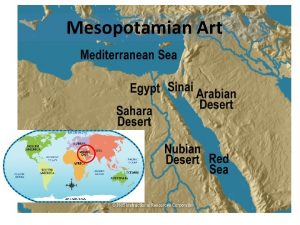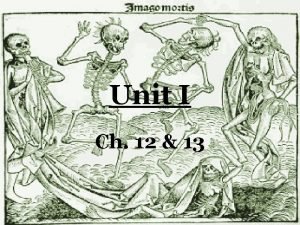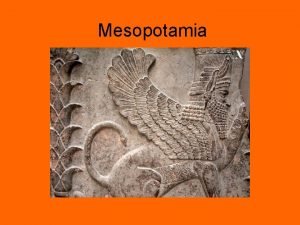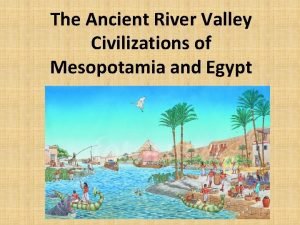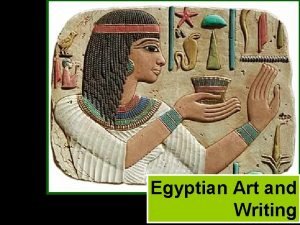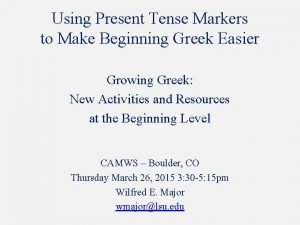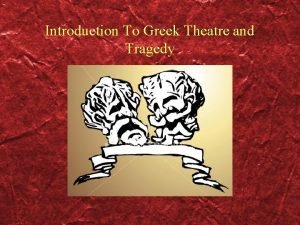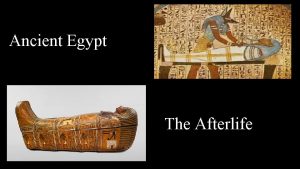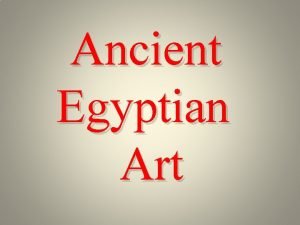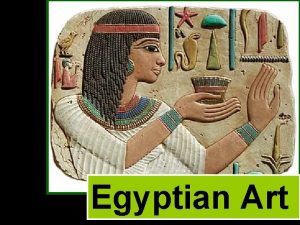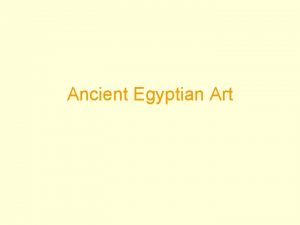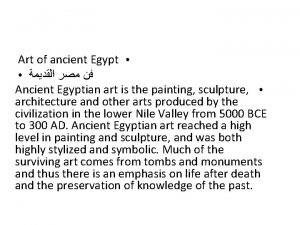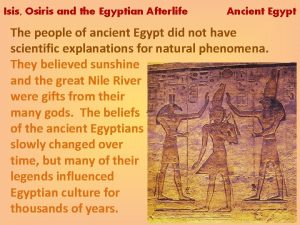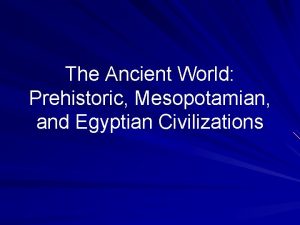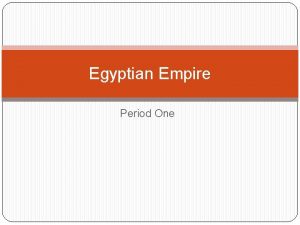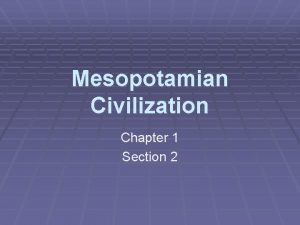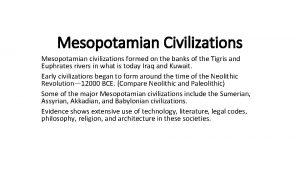Ancient Greek Art Mesopotamian Worship Egyptian Afterlife Greek







































- Slides: 39


Ancient Greek Art Mesopotamian = Worship Egyptian = Afterlife Greek = Humanism

Ancient Greek Art Can be classified into the following categories: Geometric Period ca. 900 -700 B. C. E. Orientalizing Period ca. 725 -600 B. C. E. Archaic Period ca. 625 -480 B. C. E. --- Greeks defeat Persians 480 -479 BCE --- Early Classical Period ca. 480 -450 B. C. E. High Classical Period ca. 450 -400 B. C. E. Late Classical Period ca. 400 -330 B. C. E. Hellenistic Period ca. 330 -31 B. C. E.

Ancient Greek Art n n Most of the ancient Greek art that is still around today is in the forms of pottery, sculpture and architecture. Most ancient Greek paintings have deteriorated or been destroyed, except for most paintings on pottery. q Why are they gone? n n n Greek painters worked mainly on wooden panels, which deteriorated over time. One of the sad facts of ancient history is that when marble is burned, lime is produced, and that was also the fate of the great bulk of Greek marble statuary during the Middle Ages. Likewise, the shortage of metal during the Middle Ages led to the majority of Greek bronze statues being melted down. Those statues which had survived did so primarily because they had been buried and forgotten, or as in the case of bronzes having been lost at sea. The great majority of Greek buildings have not survived to this day: either they had been pillaged in war, had been looted for building materials or had been destroyed in Greece’s many earthquakes. Only a handful of temples, such as the Parthenon and the Temple of Hephaestus in Athens, have been spared.

The Geometric Period The image of the man is thought to be Herakles battling the Centaur. This image demonstrates the Geometric artist not being limited to depicting scenes from daily life. The centaur is a purely Greek invention that has obviously created a problem for this artist, as no such creature has ever been seen. Even at the beginning of Greek figural art, we can see the instinct for the natural beauty of the human figure. This concept is reflected in the fact that Greek athletes exercised without their clothes and even competed nude in the Olympic Games from very early times. Hero and Centaur ca. 750 -730 BC

The Orientalizing Period This is considered one of the master works of the early 7 th century. It is unsure whether statue is of Apollo, or of the creator of the statue. If the broken hand had carried a bow, we would certainly know the depiction to be of Apollo. This figure represents the increasing interest in depicting human anatomy. Notable is the abdomen area, where the muscles are beginning to find definition. Mantiklos Apollo Thebes, Greece ca. 700 - 680 BC

The Archaic Period Male figures called kouros meaning “youth” were always depicted nude. This particular kouros figure was said to have a funerary purpose, as it once stood over a grave in the countryside near Athens. Statues such as this replaced the Geometric vases as the preferred form of grave marking. Kouros Greece ca. 600 BC

Classical Period

Hellenistic Era: Greece n n Period between conquest of Persian Empire by Alexander the Great to establishment of Roman supremacy The word, Hellenistic, is derived from the word, Hellene, which was the Greek word for the Greeks. The Hellenistic age "hellenized" the world through the spread of Greek culture and language throughout Near East, Mediterranean and Asia Minor Exported Greek culture: architecture, politics, law, literature, philosophy, religion, and art as models of perfection



Performing a libation, interior of a bowl by Makron, circa 480 BC. Paris: Louvre Procession of men, kylix by the Triptolemos Painter, circa 480 BC. Paris: Louvre Ancient Greek Pottery n n Greek pots are important because they tell us so much about how life was in ancient Greece. Ancient Greek pots were often beautifully decorated with scenes from daily life. Sometimes these scenes reflected what the pot was used for.

Shapes and Sizes Psykteres were wine coolers. Oinochoai were wine jugs. Chytra Used as cooking pots. Stamnoi were used for holding wine before mixing it with water Lekythoi were oil bottles. Hydria Used to carry water. Alabastron Small vases used by women for storing perfume or oil. Amphora Used for carrying and storing solids and liquids. Chous Used as jugs. Kantharos Used as drinking cups with two vertical handles Krater comes from a word meaning 'mix'. Kraters were used for mixing wine with water. Lekanides were small, shallow bowls used by women for storing jewellery and trinkets. Kylikes were special wine cups. The name for this large vase means 'carrying to the bath. ' Loutrophoroi were used to hold water for bathing or for washing. Pyxides were small pots in which women stored their cosmetics, powder or jewellery. • Pots came in all sorts of shapes and sizes depending on their purpose. • The Ancient Greeks made pottery for everyday use, not for display.

Greek Vase Painting n There are two main stylistic periods in Greek vase painting, black-figure and red-figure. n All stylistic periods of Ancient Greek pottery: nthe Protogeometric from about 1050 BC; nthe Geometric from about 900 BC; nthe Late Geometric or Archaic from about 750 BC; nthe Black Figure from the early 7 th century BC; nand the Red Figure from about 530 BC.

Black–Figure Technique Scene from a black-figure amphora from Athens, 6 th century BC, now in the Louvre, Paris n Black-figure is called that because the people (the figures) are black, and the background is a reddish brown. q q Black-figure technique was likely developed around 700 B. C. in Corinth. As the name implies, figures appeared, after the firing of the pot, as black silhouettes against the background of the light red or yellowish clay of the pot. Within the black figures, incised lines revealed the red clay beneath, allowing the artist to trace the inner details of the figure. Actually black figure is done all with one type of clay. The clay found near Athens has a lot of iron in it, so it looks black when it is wet. But if you fire it in an kiln where there is plenty of air getting in, the clay rusts, and turns red. This is because the iron mixes with the oxygen in the air. If you fire it in an kiln with no air getting in, the iron can't mix with oxygen, and the pot stays black. So you can have either red or black pots.

Red–Figure Technique Red-figure scene on the Belly Amphora by the Andokides Painter (Munich 2301). Munich: Staatliche Antikensammlungen n In red-figure the people are red and the background is black. q The red-figure technique was invented in Athens c. 530 B. C. The figures remained in the orange-red color of the clay, and the surrounding background was turned to black by the firing of the pot. With this, the method of detailing the figures was changed dramatically. Instead of using a sharp tool to incise lines, the painters used a fine brush, pen or reed to apply lines of color for the inner details of the figures.




Sculpture n n n Marble & Bronze Human form the most important subject Few sculptures have survived, mostly in Roman copies








n n n Parthenon Acropolis Statue of Athena Columns marble Frieze


Greek Statuary Nike, Winged Goddess of Victory



Doric Columns

Ionic Columns

Corinthian Columns


Theater n n n Theater in every major Greek city First theatrical productions - Athens Dionysus festival 500 BC q Initially a single actor accompanied by a chorus of singers q All wore masks – allowed actors to play multiple roles q All male cast – played female roles Plays sponsored by wealthy patrons

Olympics n n n Founded in 776 BC at Olympia in southern Greece Contests every four years Contests- running, chariot racing, boxing, wrestling, etc. Laurel wreath to the victor As many as 40, 000 gather at games from throughout Greece

Greek Architecture - Delphi n n Dates to 1400 BC – one of oldest sites in Greece Phythia - Oracle of Apollo q q Gave advice on decisions from personal problems to fates of cities Visitors required to pay a fee based on the importance of the question
 Roman floral designs
Roman floral designs Mesopotamian art characteristics
Mesopotamian art characteristics Afterlife in zoroastrianism
Afterlife in zoroastrianism See you in the afterlife
See you in the afterlife The afterlife of anne boleyn
The afterlife of anne boleyn Greek painting characteristics
Greek painting characteristics Ancient egyptian clothing
Ancient egyptian clothing Ancient egypt transportation
Ancient egypt transportation Byzantine period floral design
Byzantine period floral design What crops did ancient egypt grow
What crops did ancient egypt grow Ancient egypt social classes
Ancient egypt social classes Ancient egyptian interior design
Ancient egyptian interior design Egypt frontalism
Egypt frontalism Ancient egyptian toothbrush
Ancient egyptian toothbrush Ancient egyptian slaves
Ancient egyptian slaves Ancient egyptian method of multiplication
Ancient egyptian method of multiplication Ancient egyptian commoner clothing
Ancient egyptian commoner clothing Egyptian fairytales
Egyptian fairytales Ancient egyptian technology
Ancient egyptian technology What did khufu accomplish
What did khufu accomplish Egyptian mythology
Egyptian mythology Conclusion of mesopotamia
Conclusion of mesopotamia Introduction to mesopotamian civilization
Introduction to mesopotamian civilization Mesopotamian society
Mesopotamian society Introduction of indus valley civilization
Introduction of indus valley civilization Conclusion of harappan civilization
Conclusion of harappan civilization Conclusion of mesopotamian civilization
Conclusion of mesopotamian civilization Conclusion of mesopotamian civilization
Conclusion of mesopotamian civilization Frontalism egyptian art
Frontalism egyptian art Ancient communication devices
Ancient communication devices Ancient india vs ancient china
Ancient india vs ancient china Ancient indian achievements
Ancient indian achievements Prehistoric art timeline
Prehistoric art timeline 000
000 Present tense markers
Present tense markers Pastas ancient greek house
Pastas ancient greek house Introduction to greek tragedy
Introduction to greek tragedy Greek theater masks
Greek theater masks Personal pronouns in greek
Personal pronouns in greek Ancient greek flags
Ancient greek flags

